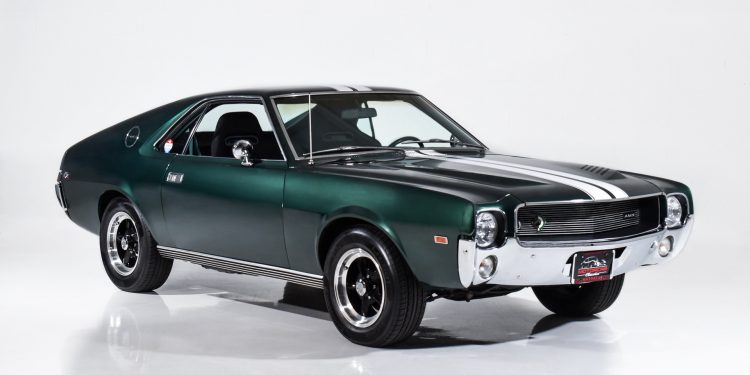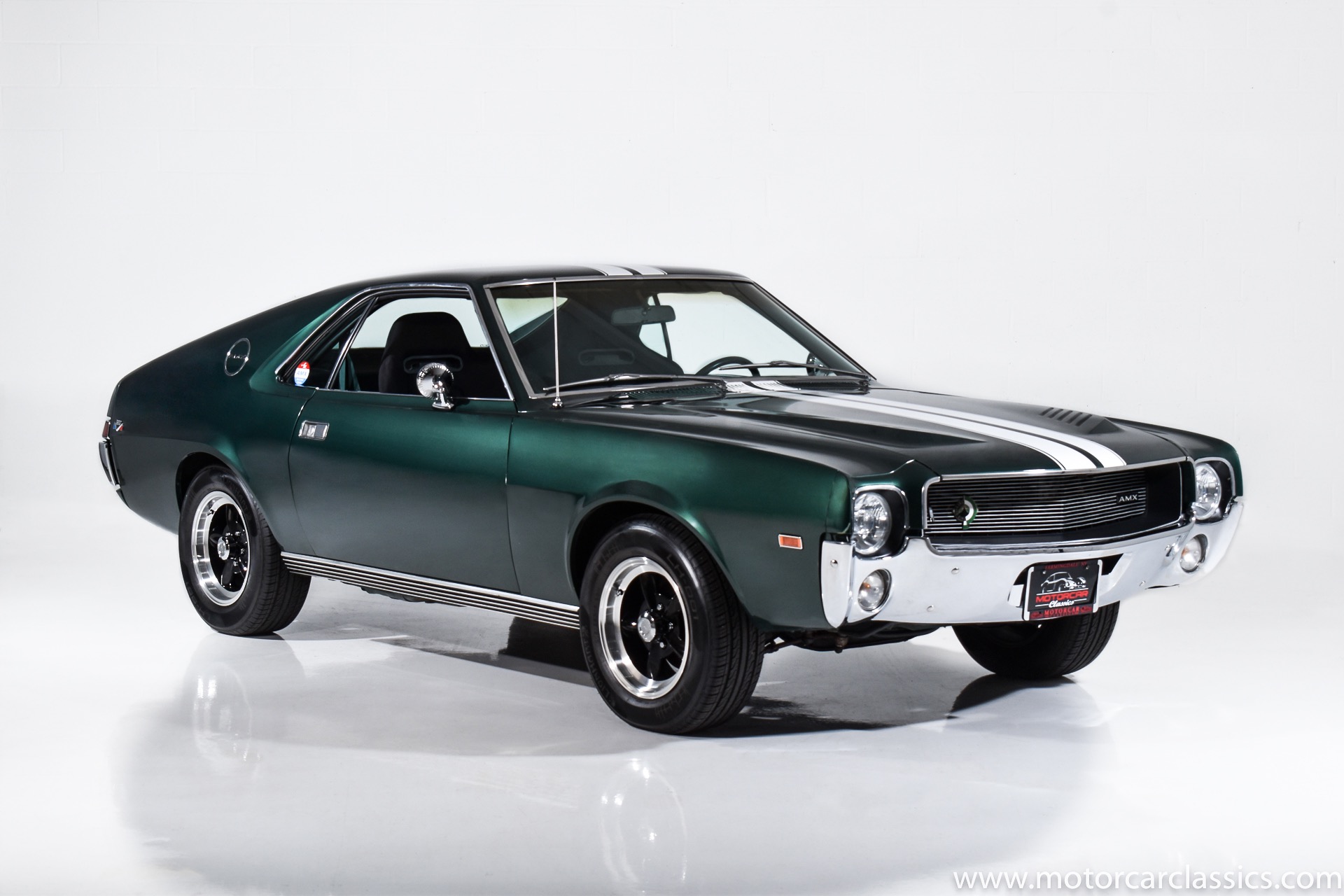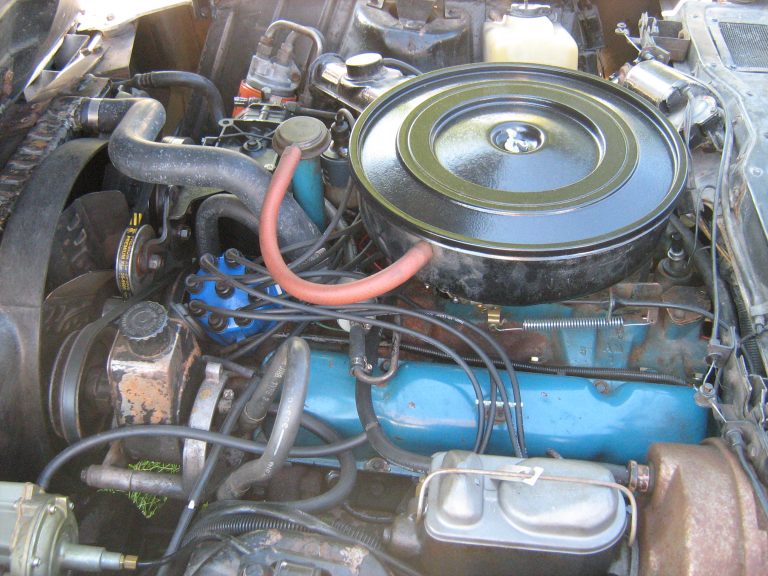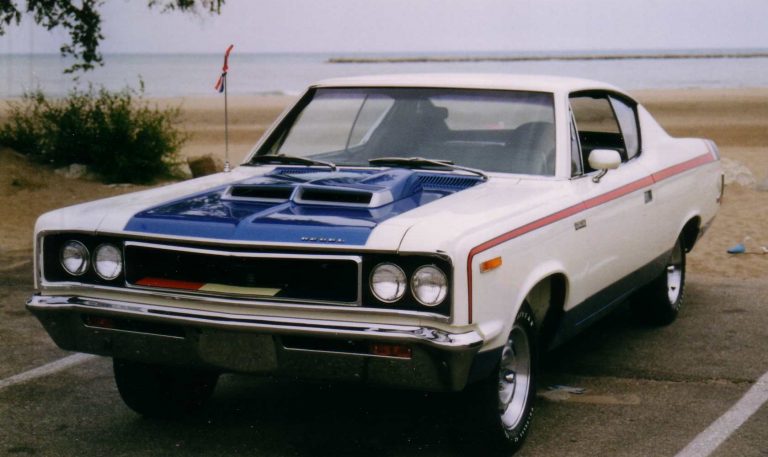AMC AMX – History, Specs & Performance

Meet Austin
Austin has been a muscle car enthusiast since an early age with his Dad having a collection including a 1965 Mustang, 1968 Mercury Cougar, and a 1969 Mustang Mach 1 among many others. Austin received a technical writing degree from University of Colorado Denver with the intentions of becoming an automotive journalist. His automotive knowledge, enthusiasm, and hands on experience allow him to craft detailed, accurate, and high-quality articles for the passionate Muscle Car Club audience.
When muscle cars come up in conversation, which are the ones that you hear most? Maybe the Plymouth Barracuda, Chevy Chevelle, Pontiac GTO, or perhaps the Ford Mustang. Well, I can tell you one that doesn’t come up very often, the AMC AMX. Some of that could boil down to the fact that American Motors Corporation AMX doesn’t exactly flow off of the tip of the tongue in the same way that “Shelby Cobra” does, for example. Another reason is the fact that AMC didn’t receive nearly the amount of airtime or widespread support as Detroit’s big three.
That isn’t to say that AMC didn’t build some cool muscle cars. In fact, they had a few notable additions to the 1960s American muscle car lore. The AMC Hurst Rambler, AMC Javelin, and AMX were AMC’s main contributions to the muscle car sphere, none of which are likely to exist if famous automotive designer Dick Teague didn’t board AMC’s sinking ship in the early 1960s. AMC was far more popular for their non-sporty models, like the Jeep XJ and Jeep CJ.
The AMC AMX was the result of desperation from AMC. Prior to the AMX, and Dick Teague’s tenure as Vice President of Automotive Styling, AMX was a family brand focused on small, practical, family cars (see the Gremlin and Pacer). The AMX was a direct attack on the big boys, providing Corvette-esque performance for much less. It could also be purchased with a 390 cid V8 engine, adding some serious bite to the bark.
AMC History
Before we jump too deep into the specifics of the AMC AMX, let’s first talk about the company behind the car. The American Motors Corporation is a conglomerate built from conglomerates. At the time, the Big Three, including General Motors, Ford, and Chrysler, were so dominant in the domestic automotive space that there was simply no way to compete for serious sales.
As a result, a merger was formed between two well-known, but past-prime, US automakers called Nash-Kelvinator and Hudson Motor Company. Nash-Kelvinator was a conglomerate in itself, comprised of Nash Motors and Kelvinator Appliance Company. The AMC merger was the largest in US history at the time, with assets worth $335 million. Funny enough, that made them the fourth largest American automaker, behind the Big Three of course.
AMC didn’t do very well overall and struggled to sell their more upscale luxury models throughout the 1950s. Throughout many years in the 1950s, AMC operated at a loss, with only their small, compact models truly selling decently. As a result, focus shifted to exclusively making smaller cars for the rest of that decade. Dick Teague, who had previously worked for General Motors, Packard, and Chrysler, was brought on to help shift the company’s focus to entice younger buyers with more modern designs.
In the early 1960s, the AMC team worked to implement fresh designs and modern technology into their upcoming projects. Modern safety implementations also made their way into AMC cars, like tandem master brake cylinders and an early PRNDL automatic shifter. The 1960s were a much better decade for AMC, as small cars began to take off in the consumer market. At the end of the decade, a push was made for AMC to produce their own muscle cars. The AMC AMX was the result of that push.
AMC Javelin
We’ve already written an article on the AMC Javelin. For that reason, we’ll keep it brief. When it comes to the AMC AMX, it’s impossible to gloss over the importance that the Javelin played in the development of the AMX itself. In many ways, you can look at the AMC Javelin as the springboard that brought the AMX to fruition. The AMC Javelin was released as an experiment to test the American car market’s interest in compact pony cars with plenty of power.
The Javelin was developed out of the prototype AMC AMX that the American Motors Corporation had been parading around auto shows since the mid-1960s. Similar to the prototype, the AMC Javelin retained sporty styling with a sloped “semi-fastback” while still utilizing the Ramber American compact chassis. The AMC Javelin came with multiple engine options, including a 232 cid straight-6, 4.8L V8, or optional 343 two-barrel high-performance V8.
The Javelin strategy ended up working. Extremely well, in fact. The median age for Javelin buyers was a decade younger than the typical AMC buyer. That was enough convincing for the AMC board of directors. The year after the AMC Javelin released, AMC greenlit Dick Teague’s AMC AMX project. This time with an even more pointed focus on performance. The AMC Javelin would continue to sell well into the 1970s, with the final Javelin model being released in 1974. The Javelin ultimately ended up outliving the AMC AMX.
1968 AMC AMX

In the late 1960s, there was a segment of the American performance car market that was only occupied by a single beast. That segment was two-seat sports coupes. Brownie points for guessing the model before the next sentence. GM fans might recognize that the Corvette was the only mass-produced American car sitting atop that pile. After the success of the AMC Javelin, Dick Teague decided to hone in on that layout, thus giving way to the AMC AMX. To elaborate on that even further, Teague wanted the AMC AMX to have Corvette performance for a significantly cheaper price. I’m sure the engineers were thrilled.
Upon first inspection, there was very little differentiation between the AMC AMX and the AMC Javelin that was released a little over a year earlier. Both cars shared numerous body panels and featured very similar styling overall. The biggest differences between the two models were the engine options and the length of the chassis, at least initially. Unlike the AMC Javelin, which was available with a straight-6 engine, the AMX only received V8 engine options. The AMX was also around a 12-inch longer chassis, which AMC claimed was entirely unique.
For the first part of its lifecycle, the AMC AMX was only offered in a two-door, two-seat, hardtop configuration. Upon release, there was a multitude of engine options available, three in total, all of which were part of the carbureted four-barrel AMC small-block engine family. The AMX also came with traction bars, wider tires, and a T-10 manual transmission.
1968 AMC AMX Engine Options
Upon its initial release, the AMC AMX came optioned with one of three engine options. All of the motors are part of the AMC Gen-2 small block engine family, sharing the same external block size. The AMC Gen 2 small block architecture was revised from the previous generation, with some key differences. Gen 2 AMC small blocks made use of thin wall casting, meaning that they were significantly lighter than other engines of a similar size. The lower-tier engine options in the AMC AMX included the AMC 290 V8 and the AMC 343 V8. While somewhat underpowered, the AMC 290 V8 was a popular engine option in the AMX. The AMC 343 V8 was even more common, as the slightly larger displacement allowed for horsepower figures close to 300.
| Engine | Displacement | Horsepower/Torque | 0-60mph | 1/4 Mile |
| AMC 4.8L Four-Barrel V8 | 4.8L / 290 cid V8 | 225 hp/ | ≈ 10.3s | ≈ 19.4s |
| AMC 5.6L Four-Barrel V8 | 5.6L / 343 cid V8 | 290 hp/ | 6.3s | 15s |
| AMC 6.4L Four-Barrel V8 | 6.4L / 390 cid V8 | 315 hp /425 lb-ft | 5.7s | 14.4s |
Ultimately, the AMC 390 V8 was the star of the show in the AMX. In fact, the 6.4L V8 received such a buzz in the AMX that it is often colloquially called the AMX 390. Due to the fact that AMC was on a tight production timeline for the AMX, they decided to use forged pistons and connecting rods in the AMX 390 to ensure maximum strength. This was done as AMC didn’t have time to test the strength of cast components.
1969 AMC AMX
After a successful first year with the AMX, AMC didn’t change a whole lot for 1969. The AMX formula remained largely untouched and still shared a chassis with the AMC Javelin and the AMC Ramber American. 1969 was the last year that the AMX used coil spring front suspension with parallel leaf spring rear suspension and trunnions instead of ball joints.
The most significant revisions to the 1969 AMC AMX were cosmetic rather than functional. Additional paint colors, including racing stripes, were added to the AMX build sheet. We’ll cover the AMC “Big Bad” paint options in a following section. Changes were made to the AMX’s gauge cluster, with the speedometer revised to read up to 140 mph and a 0-8,000 rpm tachometer mounted centrally.
Other quality-of-life improvements, like refreshed carpeting, new leather upholstery, and upgraded interior door panels, were all introduced in 1969 as well. Last, but certainly not least, all AMC AMX models received a floor-mounted Hurst shifter during and after the 1969 model year. All of the engine options from 1968 remained and no new engines were added.
1969 AMC AMX Engine Options
As we said in the section prior, there weren’t any notable changes to the 1969 AMC AMX engine options. They remained almost entirely unchanged from the 1968 model year.
| Engine | Displacement | Horsepower/Torque | 0-60mph | 1/4 Mile |
| AMC 4.8L Four-Barrel V8 | 4.8L / 290 cid V8 | 225 hp/ 300 lb-ft | ≈ 10.3s | ≈ 19.4s |
| AMC 5.6L Four-Barrel V8 | 5.6L / 343 cid V8 | 290 hp/ 365 lb-ft | 6.3s | 15s |
| AMC 6.4L Four-Barrel V8 | 6.4L / 390 cid V8 | 315 hp /425 lb-ft | 5.7s | 14.4s |
1970 AMC AMX
1970 was a big year for the AMC AMX. Following the 1969 model year, the AMX saw some extensive revisions and changes. These spanned from powertrain options to the chassis itself. Significant changes made to the AMX’s styling were the most striking difference between early-model and late-model AMXs. Compared to the earlier model, the facelifted 1970 AMC AMX featured an elongated front end, a full-width grille and headlight design, an induction-style hood, and a 2-inch longer body overall.
Other chassis-related changes included the switch to upper and lower control arm suspension with ball joints from trunnion-style front suspension. This made the 1970 AMX’s handling more comparable to the Ford Mustang and other similar cars in that segment. The AMX also received rear-suspension-stiffening torque links to aid with hard launches.
AMC also took a few pointers out of the Pontiac handbook and included bucket seats in 1970+ AMC AMX models. While leather wasn’t included, it was a $34 option in the AMX. Beyond those internal changes, the AMX also received a woodgrain dash, a center console, and a new, racier steering wheel.
There were also some big changes under the hood. 1970 saw the end of the 290 cid V8 and 343 V8. Part of this was due to the antiquated design of these engines. The AMC Gen 3 tall block engines were released in 1970, causing the extinction of most of the previous AMC small blocks. The 1970 AMC AMX is widely considered to be the last true AMX, as the AMX became the top-model AMC Javelin after that year.
1970 AMC AMX Engine Options
As we just stated, 1970 was the first year of the Gen 3 AMC tall deck small block architecture. The primary change between the Gen 2 AMC V8 and Gen 3 AMC V8 was the difference in deck height. This allowed for more displacement to be extracted from a similar block. In addition to the added displacement, the Gen 3 AMC V8 small block received revised cylinder heads with impressive flow characteristics. The Gen 3 52cc cylinder heads with dog-leg exhaust ports flowed around 20% better than the ones found on previous models. These heads, found on the AMC 360 V8 and AMC AMX 390, are highly sought after for this reason.
| Engine | Displacement | Horsepower/Torque | 0-60mph | 1/4 Mile |
| AMC 5.9L Four-Barrel V8 | 5.9L / 360 cid V8 | 290 hp / 395 lb-ft | 6.3s | 15s |
| AMC 6.4L Four-Barrel V8 | 6.4L / 390 cid V8 | 315 hp / 425 lb-ft | 5.7s | 14.4s |
For the 1970 AMC AMX, the base engine became the AMC 360 V8 which produces a respectable 290 horsepower. The only other option available was the AMC 390 AMX V8 which received a power boost to 325 horsepower due to the larger heads. Both engines were only available with four-barrel carburetors. It is generally concluded that the Gen 2 AMX 390 was only included in the facelifted AMX due to its strong reputation up to that point.
1971 AMC Javelin AMX
While 1970 was the last official year that the AMX existed as a standalone model, the AMX name continued to live on as the most premium trim level of the AMC Javelin. The 1971 AMC Javelin AMX was no longer a two-seater as all previous AMC AMXs were. Instead, the 1971 AMX was built on the larger Javelin chassis, making it a four-seater instead. The 1971 model year was a significant one for the Javelin, as it received a massive styling overhaul and utilized new engine options.
As with the AMX’s visual refresh from the year prior, the revised Javelin was put under the knife. The resulting car was extremely striking and seemingly future-proof. The 1971 Javelin AMX received massive bulging wheel arches, a pronounced roof spoiler, and a seriously long hood. It is clear that the styling of the 1971 AMC Javelin AMX borrowed heavily from both the Corvette and Mustang Mach 1, but did so in a tasteful and unique way.
In addition to the shared aesthetic changes with the AMC Javelin, the 1971 AMX also received Trans-Am-like modifications to the base Javelin. Some of these additions included a fiberglass induction hood, and front and rear spoilers. The rear spoiler on the 1971 AMC AMX was extremely functional as well. The Penske Racing Team determined that the spoiler was good for an additional 100 lbs of downforce at racing speeds.
1971 AMC AMX Engine Options
Despite the fact that the AMX was technically a trim option for the AMC Javelin in 1971, the AMX received unique engine options for the 1971 model year. All of the AMC AMX’s engine options were high-tier Gen 3 AMC tall deck small block engines. The AMC Javelin AMX received a total of three engine options for the 1971 model year, including the 304 2-barrel V8, 360 cid four-barrel V8, and the AMC 401 V8.
| Engine | Displacement | Horsepower/Torque | 0-60mph | 1/4 Mile |
| AMC 5.9L Four-Barrel V8 | 5.9L / 360 cid V8 | 290 hp / 395 lb-ft | 6.3s | 15s |
| AMC 6.4L Four-Barrel V8 | 6.4L / 390 cid V8 | 325 hp / 425 lb-ft | 5.7s | 14.4s |
| AMC 6.6L Four-Barrel V8 | 6.6L / 401 cid V8 | 330 hp / 429 lb-ft | 5.3s | 14.1s |
It is also important to note that the 1971 AMC AMX is an extremely rare car, with only around 2,000 models being made that year. As a result, AMC 1971 Javelin AMXs equipped with the highest-tier AMC 401 V8 engine are highly sought after, rare, and valuable.
1972 AMC Javelin AMX
While the AMC AMX name carried on until 1974, when it died with the Javelin, 1972 was the last true year for the AMX. During the mid-1970s, the pony car market became obsolete almost overnight due to the 1973 oil crisis, which made large displacement V8s a terrible option from a consumer standpoint. In addition to the oil crisis, US emissions regulations were getting increasingly strict, also damaging the muscle car market. This, of course, wasn’t a problem exclusive to AMC and affected every American car manufacturer.
With that being said, the impending doom of the pony car had not entirely set in yet, but horsepower ratings were changed to more modern SAE horsepower ratings which dramatically affected on-paper horsepower figures. Despite being the same engine, the AMC 401 V8 changed from a 330 horsepower rating in 1971 to 255 net horsepower in 1972. That is never a good look when it comes to advertising.
In terms of the AMC Javelin AMX itself, there were only minor design changes to the model year prior. Perhaps most notably, the 1972 AMX received an “egg crate” grille and a rear taillight cover to match. While certainly fitting with 1970s styling, the 1972 AMX did not age as gracefully as the models before it. The 1972 AMX received the same engine options as the year before, yet with revised horsepower ratings.
AMC AMX “Go-Package”
Over the lifecycle of the AMC AMX, one of the most popular performance options was the AMC AMX Go Package. In addition to all of the race-ready goodies that came standard on the regular AMC AMX, the Go Package added additional specialized performance parts. These ranged from front disk brakes to better suspension, to upgraded differential options. These AMC “Group 19” parts, as they were called, varied by model year.
In 1968, the AMC AMX Go Package cars were only available with the highest tier 343 V8 and 390 V8 engine options. Suspension enhancements included stiffer springs and beefier sway bars. Standard AMC AMX models came with 10-inch drum brakes all around, which were upgraded to disk brakes with the AMX Go Package. Red stripe performance tires were also an inclusion on Go-Package-equipped cars. The 1968 and 1969 Go Package cars shared most of the same performance parts.
With the introduction of new engine options in 1970 came some changes to the AMX Go Package formula. For one, it was only available with the 5.9L V8 and 6.4L V8 engines. Like the previous AMC Go Packages, the 1970 and 1971 options came with wider tires, disk brakes, upgraded suspension, and a ram-air induction system that makes use of the functional fiberglass induction hood.
AMC AMX “Big Bad” Color Options
Paint codes are a surprisingly massive talking point when it comes to the AMC AMX as well. Over the AMX’s lifespan, the model was available in a massive amount of colors, both in terms of body colors and racing stripe colors. Not only did special edition AMC AMXs often get their own unique color code, AMC also introduced a special palette of colors for 1969+ AMC AMX and AMC Javelin models. These were deemed the AMC “Big Bad” colors.
In total, there were three primary AMC Big Bad colors available. These included AMC Big Bad Green, AMC Big Bad Orange, and AMC Big Bad Blue. These colors received their own paint codes. Big Bad Green received the 4A paint code, Big Bad Orange received the 3A paint code, and Big Bad Blue received the 2A paint code. These colors weren’t for the faint of heart or those that wanted an inconspicuous ride. That’s for sure. Their fluorescent, neon appearance no doubt netted some serious speeding tickets back in the day.
Ultimately, very few Big Bad models were ever made. That makes them extremely collectible today. In total, there are 358 Big Bad Green AMC AMXs, 405 Big Bad Orange AMC AMXs, and 309 Big Bad Blue AMC AMXs known to exist.





